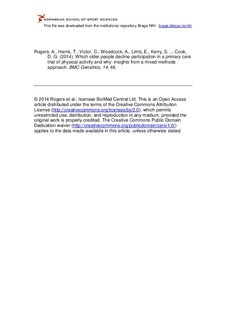| dc.description.abstract | Background: Physical activity is of vital importance to older peoples’ health. Physical activity intervention studies with older people often have low recruitment, yet little is known about non-participants.
Methods: Patients aged 60–74 years from three UK general practices were invited to participate in a nurse-supported pedometer-based walking intervention. Demographic characteristics of 298 participants and 690 non-participants were compared. Health status and physical activity of 298 participants and 183 non-participants who completed a survey were compared using age, sex adjusted odds ratios (OR) (95% confidence intervals). 15 non-participants were interviewed to explore perceived barriers to participation.
Results: Recruitment was 30% (298/988). Participants were more likely than non-participants to be female (54% v 47%; p = 0.04) and to live in affluent postcodes (73% v 62% in top quintile; p < 0.001). Participants were more likely than non-participants who completed the survey to have an occupational pension OR 2.06 (1.35-3.13), a limiting longstanding illness OR 1.72 (1.05-2.79) and less likely to report being active OR 0.55 (0.33-0.93) or walking fast OR 0.56 (0.37-0.84). Interviewees supported general practice-based physical activity studies, particularly walking, but barriers to participation included: already sufficiently active, reluctance to walk alone or at night, physical symptoms, depression, time constraints, trial equipment and duration.
Conclusion: Gender and deprivation differences suggest some selection bias. However, trial participants reported more health problems and lower activity than non-participants who completed the survey, suggesting appropriate trial selection in a general practice population. Non-participant interviewees indicated that shorter interventions, addressing physical symptoms and promoting confidence in pursuing physical activity, might increase trial recruitment and uptake of practice-based physical activity endeavours. | nb_NO |
